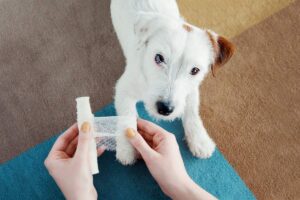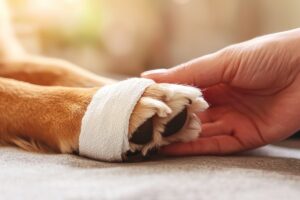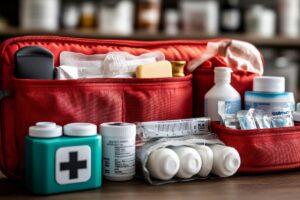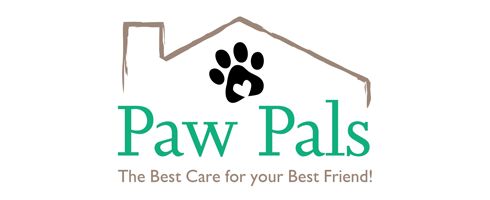Dogs are naturally curious and playful, making a potential pet injury inevitable regardless of how careful we are. Whether it’s a minor cut from rough play or a more serious wound from an accident, knowing how to handle the situation properly is essential. Quick and efficient first aid can prevent infections, reduce pain, and improve healing time.
In this guide, we will walk you through the essential steps for treating an injury or wound on a dog.
1. Remain Calm and Assess the Situation
 The first and most important thing you can do when your dog is injured is to remain calm. Dogs are very intuitive and can pick up on stress and anxiety. If you panic, your dog is more likely to become anxious and agitated, making it harder to provide care.
The first and most important thing you can do when your dog is injured is to remain calm. Dogs are very intuitive and can pick up on stress and anxiety. If you panic, your dog is more likely to become anxious and agitated, making it harder to provide care.
Take a deep breath, assess the injury carefully, and determine the severity of the wound. If your dog has a deep wound, excessive bleeding, or signs of shock (weak pulse, paleness, rapid breathing), seek emergency veterinary care immediately.
2. Restrain and Muzzle the Dog Safely
When a dog is in pain, even the gentlest pet may react by biting instinctively. To protect yourself and ensure you can safely tend to the injury, it is crucial to restrain or muzzle your dog.
Here are some tips for safely restraining your dog:
- Use a leash or a piece of cloth to create a makeshift muzzle if you don’t have one.
- Avoid covering the nose completely; your dog should still be able to breathe comfortably.
- If the wound is near the mouth or muzzle area, be extra cautious not to cause additional pain.
- Have someone assist you in holding your dog still while you examine the wound.
If your dog is exceptionally aggressive or defensive due to pain, consider calling your veterinarian for advice before proceeding.
3. Clean the Wound (Wound Irrigation)
Proper wound cleaning is essential to prevent infection and promote healing. The safest and most effective way to clean a dog’s wound is through wound irrigation, which involves flushing the wound with clean water or saline solution to remove dirt, bacteria, and debris.
Steps for cleaning a wound:
- Rinse the wound with lukewarm water or saline solution. Avoid using hydrogen peroxide, as these can damage healthy tissue and slow the healing process.
- If you don’t have a saline solution, you can create a simple one by mixing a teaspoon of salt in a cup of warm water.
- Hold the affected area under running water for about 5 minutes to ensure all dirt and bacteria are removed.
If the wound is heavily contaminated with dirt or debris, move on to the next step.
4. Remove Foreign Materials Carefully
Small particles such as dirt, gravel, or thorns may still be present in the wound after rinsing. If you can clearly see the object and it is easy to remove, use disinfected tweezers to gently extract it.
However, if the debris is embedded deep, do not attempt to remove it yourself as you may cause further injury. Instead, leave it in place and seek veterinary assistance immediately.
In some cases, deeper wounds may require professional cleaning and stitches.
5. Apply Pressure to Control Bleeding
If the wound is still bleeding, it’s crucial to stop or slow the blood flow as quickly as possible. Apply a pressure dressing by doing the following:
 Place a few layers of sterile gauze (or in an emergency, a clean shirt or cloth) directly on the wound.
Place a few layers of sterile gauze (or in an emergency, a clean shirt or cloth) directly on the wound.- Press firmly but gently to slow the bleeding. Hold pressure for at least 5–10 minutes without removing the dressing.
- Avoid lifting the dressing to check on the wound, as this can disturb clot formation and cause bleeding to resume.
- Once the bleeding slows, bandage the wound to keep it protected.
If the bleeding does not stop within 10-15 minutes or is pulsating (which may indicate arterial damage), take your dog to the vet immediately.
6. Properly Bandage the Wound
Once the wound is clean and bleeding is under control, cover it with a sterile bandage to protect it from dirt and bacteria.
Follow these steps to bandage your dog’s wound properly:
- Place a non-stick sterile pad over the wound.
- Wrap the area with gauze, ensuring it is snug but not too tight to cut off circulation.
- Secure the gauze with adhesive medical tape.
If possible, use a protective wrap or cover (such as a dog boot for paw injuries) to prevent your dog from licking or chewing the bandage.
Check the bandage frequently and change it daily or if it becomes wet or dirty. Signs such as excessive redness, discharge, swelling, or a foul smell may indicate an infection that requires veterinary attention.
7. Monitor Your Dog’s Condition and Seek Veterinary Care
Even if the wound appears minor, it’s a good idea to consult your veterinarian, especially if the injury is deep or shows no signs of improvement within a day or two. Dogs often lick their wounds, which can lead to secondary infections.
Signs that your dog needs immediate veterinary care:
- Persistent swelling or redness around the wound
- Excessive discharge (pus) or foul-smelling odor
- Signs of pain (whimpering, limping, or reluctance to move)
- Loss of appetite or unusual lethargy
- Difficulty breathing or signs of infection spreading
Your vet may prescribe antibiotics, pain medication, or additional treatments depending on the severity of the wound.
8. Keep Your Emergency First Aid Kit Stocked
A well-prepared pet first aid kit can make a significant difference in how effectively you can treat an injury. Keep the following items in your kit:
 Sterile gauze and bandages
Sterile gauze and bandages- Adhesive tape
- Antiseptic wipes or saline solution
- Tweezers for debris removal
- Blunt-ended scissors
- Muzzle or soft restraint
- Disposable gloves
- Antibiotic ointment (vet-approved)
- Emergency vet contact numbers
Having these essentials handy ensures you can act quickly in an emergency.
Book a PetTech Certified Pet Sitter
Accidents can happen at any time, and knowing how to respond quickly can make all the difference in your pet’s recovery. Staying calm, assessing the situation, and providing proper care can prevent complications and promote healing.
At Paw Pals Pet Sitting, we are dedicated to your pet’s health and well-being. Our PetTech Certified pet sitters are trained in pet first aid and CPR, ensuring that your furry friend receives expert care in any situation. Whether you need reliable pet sitting, dog walking, or specialized care for a pet with medical needs, we’re here to help.


